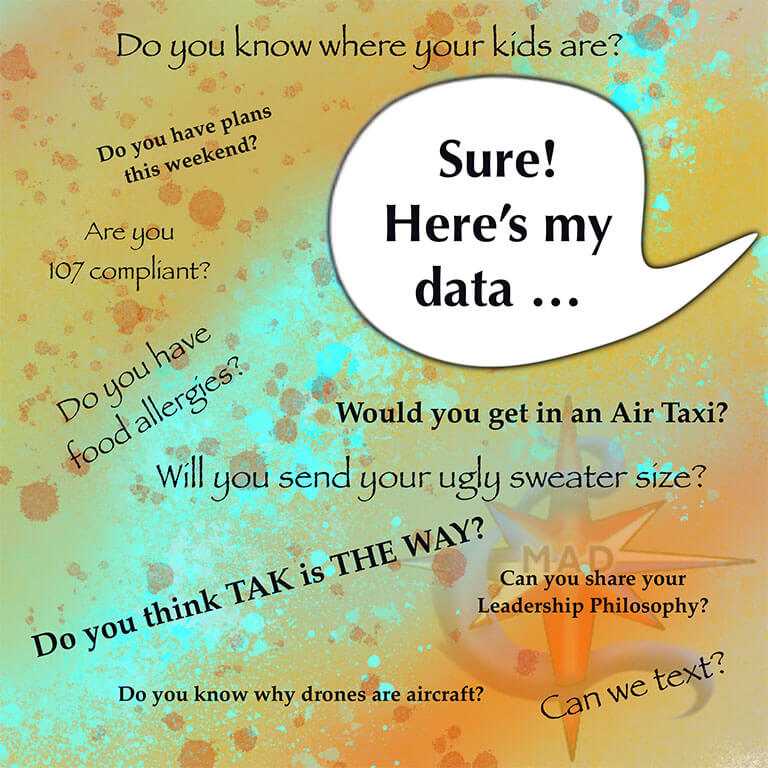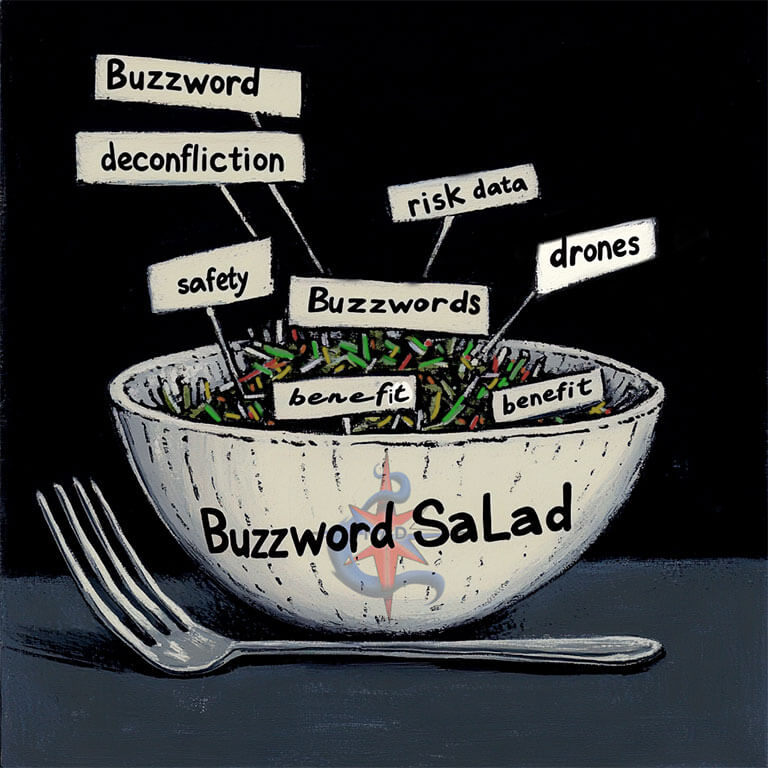By: Michelle Duquette, AG Operations Ambassador
In today’s digital age, folks use the word “data” in so many circumstances that it’s increasingly difficult to follow the conversations. The word means different things to different people. This leads to misunderstandings and slowed progress. Its misuse can even unintentionally spread false information or give the impression you really aren’t the expert you claim to be.
Yet people across government and industry continue using the word “data” – and asking for more and more of it from operators – indiscriminately every day. Understanding the nuances of “data” is not just a semantic exercise: it’s vital for fostering collaboration, interoperability and minimizing time-consuming conflict.

It Used to Be Worse
I can remember a time when two federal agencies were struggling to “share data.” The conversation went something like this:
- Agency1 – We need you to share your operational data.
- Agency2 – Ok. Tell me what you need.
- Agency1 – We need your operational data.
- Agency2 – We have terabytes of all different kinds of data that could be operational. Which specific data elements do you want?
- Agency1 – We need all of your operational data.
- Agency2 – (Blank stare.) Ok.
The outcome of this conversation was Agency 2 sterilized over 5 terabytes of “data” collected over the previous 12 months, set up a secure transfer protocol process for that data and dumped it all over to Agency1. This occurred year after year. Was that “data” ever usable by Agency1? I’m still unclear on that.
Some Role-Based Differences
At its core, “data” can represent varying concepts: insights derived from analysis, processed information or raw numerical values. To know what someone means when they ask for “data,” you need to appreciate that person’s role and understand why the information they seek might be important to them.
Analysts
An analyst is generally looking for patterns and insights to inform research or a specific project. They prefer working with lots of different pieces of information that when “sliced and diced” in various ways can reveal hidden trends or validate decisions. So, basically, everything is “data” to an analyst.
Manufacturers
Manufacturers are building technology. They are concerned with design and development standards. So “data” in this context infers technical specifications and aircraft operating performance metrics. For example, Boeing developed a specific data collection system that extracts real-time aircraft operating performance indicators from onboard sensors and transmits the readings through a combination of ground and satellite-based transmissions to the airline maintenance teams and also to servers at Boeing Operations Control Centers that give real-time assists to airlines. This information helps inform trends analysis, predictive maintenance and future upgrades for their customers.
Operators
A drone operator who refers to “data” is probably focused on the raw inputs received from the drone into the Ground Control Station (GCS). For this pilot, “data” signifies the hundreds or thousands of unrefined, initial records that capture various payload, environmental and platform parameters. In their operations, clarity is crucial. Data in its raw form is critical for developing and tuning operational performance checks for optimal flight and service excellence. These numbers are then used to inform a myriad of other business decisions.
Regulators
Regulators like the Federal Aviation Administration (FAA) approach requests for “data” from an entirely different perspective. When they request a drone operator’s data, they actually need processed information that adheres to their predefined and purpose-built metrics. This allows them, for example, to efficiently analyze a waiver submission and make a decision quickly. This can lead to statistics that are normalized into trends or correlated to safety standards. The resulting information, when analyzed, is used to inform future policy.
There’s a Law for That
Today, there are laws governing data sharing protocols, interfaces, naming conventions and security. What may not be as well known are the laws that prevent the government from placing too many data collection burdens on industry.
Every requirement related to data collection is subject to laws like the Paperwork Reduction Act (PRA) to “minimize the paperwork burden” from government “asks.”
Because of these laws, the FAA limits the number of requirement iterations they levy upon industry. This also avoids the FAA from adding additional workload to themselves. Addressing compliance with such rules, ironically, becomes an additional workload for FAA staff – the same staff supporting waiver processing, safety analysis on Certificates of Authorization or Waiver (COAs or COWs) and agreeing to speak at your conference or sit in on your webinars.
Thus, the FAA has layers of rules on “data” that unintentionally restrict their ability to move forward faster.
There is Another Way
There is a balance the FAA must maintain. It definitely involves trade-offs on how much change they can afford to make with the limited resources they have.
Instead of asking UAS operators for “data,” perhaps we would all be better served by following the practice that produced Collaborative Decision Making (CDM).
In the early 1990s, the FAA and the commercial airlines began addressing lengthy system delays. As a young aircraft dispatcher at the time, I was energized and very engaged. Our commercial dispatch community came together with the FAA people we knew well from the daily battles of operating a safe and efficient National Airspace System (NAS): the FAA Air Traffic Managers. It was tough early on. Airlines didn’t want to share too much information with the FAA for fear of further restrictions. Airlines also didn’t want to share any information with their market competitors. The FAA was struggling with how to sustain on-time performance metrics.
Together, however, these two groups quickly learned how to flex back and forth to achieve higher levels of efficiency even in the most challenging circumstances. They weren’t executives or entrepreneurs or software developers. They were operations people doing the job in the middle of severe weather season every single day. They didn’t speak in buzzwords. They spoke plainly with one another about everything, like traffic flows, runway capacity constraints, reserve fuel requirements, unacceptable reroutes, weather impacts, aircraft performance limitations and crew duty times. By speaking in specifics, they learned the nuances of the other’s perspective, needs, and capabilities.
That was the secret sauce and CDM was born.
CDM is a joint initiative by the FAA and industry stakeholders aimed at enhancing air traffic flow management within the NAS. It operates on the principle that sharing accurate information among stakeholders, including airlines, general aviation, private industry, and academia, leads to better decisions and improved system efficiency. CDM emphasizes creating a shared understanding of NAS constraints and conditions, enabling stakeholders to adapt to changing circumstances effectively. This collaborative approach ensures that decisions are made with a comprehensive view of their impact on the NAS and its users.
The CDM Executive Committee oversees the initiative by setting priorities, forming sub-teams, and recommending technological and procedural improvements to the FAA. These sub-teams focus on specific challenges such as weather evaluation, ground delay programs, and surface operations. By fostering collaboration and leveraging advanced tools, CDM aims to optimize air traffic management, reduce delays, and enhance safety while supporting global harmonization efforts.
It’s important to recognize that CDM isn’t a replacement for standards bodies. Not at all. Think of it as what comes before standards development that helps reduce the time it takes within those meetings to get everyone using the same words in the same way. It’s about taking the time to reach common understanding together.
Today we have an entire taxonomy devoted to traffic flow management communications between airlines and the FAA. It’s a lesson our nascent UAS and AAM community would benefit from learning.

Pass on the Buzzword Salad
“Data” has become another shortcut to help us say many things in one word. The danger emerges when people of different professions get together and indiscriminately use that short cut to save time. Our community consists of people from different professions, all coalescing around the uses of drones for good, the needs for drone security, the advancement of electric flight and the evolution of how we communicate, transmit, receive, process, and generate information. Therefore, it’s so important that we be deliberate about ensuring we’re not just heard but understood.
Frustrations and loss of time and revenue are accelerated when we have to deconstruct an impasse caused by inaccurate assumptions and misunderstandings.
Don’t feed the people important to you a luncheon of buzzword salad. They will eventually starve and leave your table.
Help yourself by taking deliberate action to ensure they understand why the information is important to you with examples and context. Spend the time to reach clarity together. You’ll find the time you take to provide specificity and clarity of context to be much less than the time it might take to realign efforts after misunderstandings. It’s a worthwhile investment.

